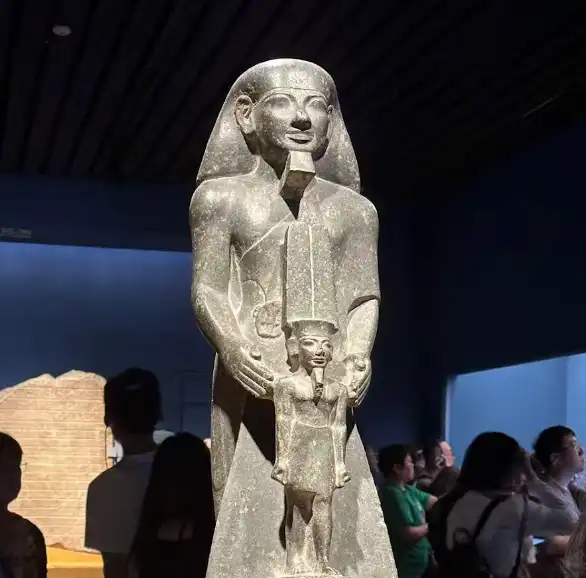Top of the Pyramid: Uncover a Mysterious Country Far Away
Walking into the Egypt exhibition, visitors see a civilization defined by its majestic pyramids, sacred animals, and powerful pharaohs, offering a glimpse into a world where religion, art, and politics merge to create a culture that continues to captivate and influence the modern imagination.

Shanghai Museum will hold the "Top of the Pyramid: Ancient Egyptian Civilization Exhibition" from July 19, 2024, to August 17, 2025, as part of the "Dialogue World" series on cultural relics and art. 2024 coincides with the 10th anniversary of the China-Egypt comprehensive strategic Partnership. This landmark exhibition marks the first collaboration between an official Chinese museum and the Egyptian government. With an impressive collection of artifacts, it will be the largest international exhibition of Egyptian cultural relics and the most comprehensive in Asia.
The exhibition unfolds through the historical timeline of Egypt, "The Kingdom of the Pharaohs," and two special topics, "The Secrets of Saqqara" and "The Age of Tutankhamun."
Upon entering the first gallery, "The Kingdom of the Pharaohs," a huge timeline appears with the words. "Egypt is a land blessed by the Nile." The Nile has been central to Egypt’s development since ancient times, not only serving as a transportation route but also flooding annually to enrich the fertile black land, giving birth to human civilization. The annual flooding cycle, aligned with solar activity, shaped the Egyptian cosmology of chaos and harmony. The Egyptians depended on the Nile for their survival, and they believed in the power of nature. They interpreted the knowledge of nature into the image of deities, whose worship became a foundational part of Egyptian religion. Egypt became one of the first regions to form a sense of cultural identity and unity.
The pharaoh statue at the center of the exhibition hall is a striking focal point, following the symbolization of the power and divinity of these ancient rulers. Pharaohs were seen as the sons of Ra, the sun god, and as the absolute rulers of Egypt. They controlled the land, economy, and religious practices, acting as intermediaries between the gods and the people to preserve cosmic balance Pharaohs commissioned grand temples, monuments, and pyramids, as symbols of their divine authority. Upon their deaths, they were regarded as Osiris, the god of the underworld and resurrection, and were entombed in the pyramids to become gods once more. The pharaoh’s governance extended through a vast bureaucracy, with officials, priests, and soldiers who ensured the stability of the empire.
In the second hall "The Secrets of Saqqara", Buster, a slender bronze cat head with two ears, draws attention as the exhibit’s central piece. The ancient Egyptians worshiped animals deeply, with many being totems of primitive tribes. The unstable life led to the climax of folk belief in witchcraft, and the worship of sacred animals became fashionable again. Cats, hawks, and crocodiles represented different deities with Bastet the goddess associated with the moon, fertility, and harvest, taking the form of a cat. Sacred animals were sometimes mummified and sold to be worshiped as apostles of God, symbolizing devotion to gods and bringing a sense of protection.
The third hall features the stories of the heroic pharaoh Tutankhamun, whose tomb discovery in 1922 captured global attention. The tombs of Egyptian pharaohs were always large-scale, reflecting their belief in an afterlife. The ancient Egyptian religious beliefs emphasized eternal life, which the social elite promoted as an essential means of domination. The "high culture" belief reinforced the pharaoh's authority and defined burial customs in ancient Egypt for over three thousand years. Ancient Egyptian burial practices date back to 2500 BC, when the Pyramid Texts said“Build a great pyramid for the pharaoh, waiting for his spirit to return”. Though costly, the tradition continued as a testament to both the authority of the pharaohs and the people's firm belief in the afterlife.
In essence, the exhibition shows that ancient Egyptian culture stands as a timeless testament to the ingenuity and spiritual depth of an ancient civilization. Its majestic pyramids, pure belief, and powerful myths reveal a society deeply committed to the pursuit of knowledge, balance, and eternal life. The legacy of the pharaohs, with their divine rule and monumental achievements, continues to echo through history, influencing generations by generations. As we explore Ancient Egypt’s rich heritage, we not only uncover the past but also connect with the universal human quest for meaning.
What’s more? Based on the important animal elements of ancient Egyptian civilization and the newly discovered cat temple in Saqqara, the museum will hold a "Meow" night during the exhibition, which allows visitors to bring their cats to the exhibition. In addition, the Shanghai Museum also designed canvas bags, key chains, refrigerator magnets, and other literary creations based on the Buster image, which are widely loved by the public.
If you want to explore more, check out this exhibition by yourself.